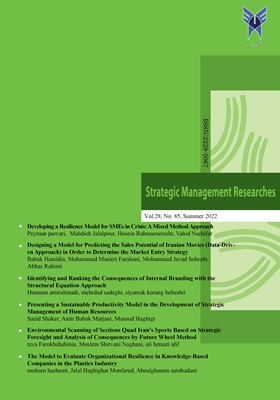Identifying and Ranking the Consequences of Internal Branding with the Structural Equation Approach (Case Study of Islamic Azad University, Khorasgan Branch)
Subject Areas : Strategic Management ResearchesHooman amirahmadi 1 , mehrdad sadeghi 2 , siyamak korang beheshti 3
1 - Ph.D. Student, Cultural Managementof Facuty Islamic Governance. Isfahan (Khorasgan) Branch, Islamic Azad University, Isfahan, Iran
2 - Assistant Professor of Facuty Islamic Governance Isfahan (Khorasgan) Branch, Islamic Azad University, Isfahan, Iran
3 - Assistant Professor of Facuty Islamic Governance Isfahan (Khorasgan) Branch, Islamic Azad University, Isfahan, Iran
Keywords: Islamic Azad University, Structural Equations, branding, Internal Brand,
Abstract :
In times of economic crisis, businesses and individuals take on more responsibility for higher education institutions; Higher education institutions are expected to have more efficient graduates and to be able to better meet the needs of employers. Universities face many challenges in developing macroeconomics and the needs of the local community. In order to survive in the higher education market, it is necessary to formulate policies that consider them as providers of educational services, and students, faculty and staff as the most important direct stakeholders. Therefore, it is necessary to study the effects of internal branding. From this research, the consequences of internal branding have been identified and ranked with the approach of structural equations of Islamic Azad University, Khorasgan branch. The present study is an applied research and in terms of the method of conducting a mixed research (qualitative-quantitative). The statistical population of the study is 12 experts. In the qualitative part, their opinions have been used to identify the effects and for modeling, the statistical population consists of a group of experts and professors of Khorasgan University, whose number was 440 people. Then, according to Krejcie and Morgan table, the sample size 205 people were obtained. Sampling method. In this research, sampling is available. Internal brand effects are first identified by Delphi technique, then structural equations and confirmatory factor analysis are modeled and ranked. Finally, the results showed that the internal branding consequences of Khorasgan University have 6 major outcomes for the organization, which are in order of priority. Organizational, national and international implications, individual implications, financial implications, cultural implications, and ultimately implications for employees.
آزاد، ناصر، فاطمی فر، آزاده، قائم مقامی فراهانی، خدیجه (1397) شناسایی اجزای DNA برند در آموزش عالی (مطالعه موردی دانشگاه آزاد اسلامی)، مدیریت کسب وکار، 10 (37) .7-33
باقری، سید محمد، حسینی، سید محمود، سورنا، آریایی (1399). تاثیر برندسازی درونی برجایگاه یابی برند شرکت های کوچک و متوسط استان مازندران، بازاریابی پارس مدیر، شماره15 .28-38
رحیمیان، اشرف (1397). برندسازی دانشگاه؛ نیاز جدید آموزش عالی (مطالعه موردی؛ دانشگاه پیام نور مرکز کرج)، مدیریت و برنامه ریزی در نظام های آموزشی،11(1) . 158-139 .
شفیعا، سعید؛ سید نقوی، میرعلی (1398). الگوی برندسازی درون سازمانی در بخش خدمات و گردشگری تهران، مطالعات مدیریت گردشگری، دوره 14 ،شماره 46 ، 109-79 .
منوریان، عباس؛ صفویه، جواد؛ آقاخانی، نرگس؛ رضایی نور، جلال (1396) .بررسی عوامل مؤثر در تدوین استراتژی های برندسازی دانشگاه های مبتنی بر آموزش الکترونیکی، دوره 11 ،شماره 3 ، .221-236
Clark. Paul, Chapleo. Chris, Suomi. Kati,(2019), Branding higher education: an exploration of the role of internal branding on middle management in a university rebrand, Tertiary Education and Management, https://doi.org/10.1007/s11233-019-09054-9, pp: 1-19.
Hosseini, M.H. & Farhadi Nahad, R. (2013), Investigating Effective factors Brand Value in higher education (case study: Payame Noor University), Modisiat-e Farda, 12 (35).
Kashive. Neerja, Khanna. Vandana Tandon ,(2017), Impact of Internal Branding (IB), Brand Commitment (BC) and Brand Supporting Behavior (BSB) on Organizational Attractiveness (OA) and Firm Performance(FP).,International Journal of Human Resource Studies ISSN 2162-3058 2017, Vol. 7, No. 2,pp 155-174.
Leijerholt. Ulrika, Galina Biedenbach &Peter Hultén(2021) Internal brand management in the public sector: the effects of internal communication, organizational practices, and PSM on employees’ brand perceptions, Public
Management Review, ,https:// doi. org/10.1080/14719037.2020.1834607
Mihaelaa, Diaconu. Amalia, Pandelica (2012), “The partnership relationship between economic academic and business environment, component of modern university marketing orientation”, Procedia - Social and Behavioral Sciences 62,
722 – 727.
MacLaverty N, Goom S, McQuillan P, Oddie H; (2008), Internal Branding – A Human Resources - Perspective, Canadian Marketing Association.
Raj P. D, Cheryl L. B, Timothy W. A, & Kimberly M. J (2010), “Building brand community-membership within organizations: a viable internal branding alternative?” Journal of Product and Brand Management, 19 (3), PP: 210-217


